| Jimi Hendrix Bought
Our Cooker. Continued When
Trapeze
came into existence in 1969 one of their first ports of
call was the London club scene, playing at Rasputin's
and at the Bag O'Nails. Like the future Slade, it
was in the London clubs that they were first seen by the
people who were going to prove so influential to their
future development, John Lodge and Justin Hayward.
The club scene was not restricted to London, it had been
developing throughout the decade all over the country,
especially in the other major centres of population. |

Trapeze.
Wolverhampton's original 'super-group' with Glenn
Hughes, Mel Galley, Terry Rowley, Johnny Jones and Dave
Holland. While they began their life as a five-piece
they would ultimately become a pretty successful trio.
(Mel Brookes) |
The nature of the clubs, their
management and clientele often determined the nature of
the groups who played at those clubs and the style of
music played by the groups and the amount of variety
included in their acts etc.
While for many groups the round of
clubs may have seemed like a depressing treadmill, it
was fairly lucrative and the financial rewards probably
kept many groups together longer than might have been
expected. This was not just true for some of the area's
groups but for other more famous combinations like the
Searchers and the Hollies. |
|
Amongst the more
famous clubs in the West Midlands was Le Metro in Livery
Street in Birmingham which most of the area's groups
played at some point or other. More locally, the
Lafayette became the major venue with some of the
most famous performers of the late 60's and early 70's
appearing there. It became rather like a headquarters
for those local groups who worked under the Astra
banner. For some of those groups the club scene hastened
their movement from beat or pop group to cabaret
performers since they started to play clubs which
insisted on cabaret performances.
The Montanas
had always included elements of comedy in their stage
act, so the movement over to cabaret was probably
simpler for them. Bill Hayward remembers the
early days of the group:
"The tapes we used were
designed to add an element of variety to the act and
give us a certain advantage over the other local groups.
Terry and I used to put the tapes together at home. In
fact, we did a lot of our rehearsing in his house at 300
Penn Road, one of the coldest houses in the world or so
it seemed" |
|
"Cabaret
venues loved the comic sketches, as did most of our
fans. It became our trademark, especially sketches like
Batman and Round The Horne. Such sketches definitely
took a great deal more rehearsing than the ordinary sung
numbers, but it was worth it."
"The one
drawback however was that the Montanas became a copycat
band, even the sketches were based on others' work. That
maybe accounts for our failure to get the hit that we
should have got. It’s interesting that our best record
was Let’s Get A Little Sentimental and that was recorded
by the Montanas II with Sludge Lees, not Johnny Jones on
vocals and with George Davies, not Terry Rowley."
|
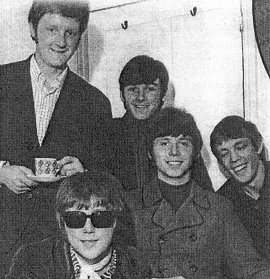
Montanas.
The Monts who specialised in a very original and funny
mime act as well as being a really excellent group.
(Trevor Westwood) |
|
Johnny Jones
sees the group as something of a Jekyll and Hyde, in
terms of their stage performances:
"We could be
described as the town s schizophrenic band in that we
would often be playing two completely different sets
within one evening. We might do a pop gig early in the
evening and a variety or cabaret gig later. We appeared
with such variety acts as Vera Lynn, Jack Douglas and
Dora Bryan, especially on Sunday evenings. It took
something special to be able to cope with both extremes.
The Montanas could do that."
"The first
time we did one of the mimes was in Bilston and it
involved simply putting a microphone by an old record
player and speeding up the track. The first track we
used was I Go Ape by Neil Sedaka. It might seem a bit
dated nowadays but it was really popular then,
especially when we started to use the Goons and Kenneth
Horne tapes."
Another member
of the Montanas was Jake Elcock and he
tells us that the decision to get involved in cabaret
was a group decision:
"We all
agreed that cabaret was the logical next step for the
group. We had been messing around with the tapes and so
on and as we got more work in the cabaret clubs in the
North East and Yorkshire, it seemed wise to develop into
a cabaret act. We did that and became quite successful
at it. If you were not willing to extend into outright
comedy then you would not get the work. It s like the
old saying 'He who pays the piper, calls the tune '."
Finders
Keepers was one of the
area's most successful cabaret club groups, as they
still are. As Roy 'Dripper' Kent describes:
"We were
never going to be as good as the Montanas at that sort
of thing. They were the best at that style of
performance. However, we had to make changes as we
started to play different venues, especially in the
North East. We found that the more variety in the act,
the better the punters liked it. In fact, the dafter,
the better."
"Alan and I
found we had this tendency towards comedy so we pursued
it, especially when we discovered just how much money
could be made on the cabaret circuits. That was
particularly true of the Northern circuits in the 60s."
"The first
time we went up North, the opportunity came out of the
blue. Roger Allen phoned us up the one day when we were
rehearsing at the Jazz Club in Dudley and explained that
he had had a call from a club in Newcastle which needed
an urgent replacement for their cabaret star of the
week, Yana. We went straight up."
"The first
night we did a lot of Barron Knights' type stuff which
obviously included a lot of comedy and mimicking. It
went down really well. The next night we did
straightforward pop stuff and it flopped. The manager
demanded that we continued with the comedy stuff which
we did and it went well again, so we kept at it. "
|
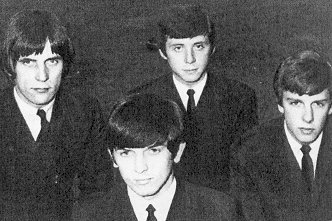
Finders
Keepers. An intense
looking Finders Keepers, not at all the image that they
portrayed on the cabaret stage. |
"When I was
with Light Fantastic we went up to the Northern clubs
again and of course the horror act was about as music
hall or variety as you could get.
The one other
difference was that Richie Brown, the lead guitarist had
classical ability and we would all leave him to play his
classical bit. It also went down really well."
|
|
Alan Clee
confirms much of what Dripper says about the cabaret
times for the group in the 60s:
"We could do
any amount of straight pop but if we were going to make
it with those cabaret audiences in the North we had to
be funny. We found that sketches like Hilda Baker and
Cynthia went down particularly well. Dripper’s height
made him ideal for Hilda and my height made me ideal for
Cynthia. We have kept that routine through the years."
Whatever the
changes which occurred to the groups in terms of
personnel, style of music, range and type of venue and
so on, as the decade came to its end other factors began
to have significant effects. In the early days audiences
expected the groups to re-create the sounds of the chart
hits because of the desire to dance. Groups were judged
by their 'nearness' to the original and heavily
'penalised' if they failed to reach the required
standard. Most group instrumentalists and singers got
somewhat bored by this slavish copying and sought
artistic independence as an ultimate goal, although it
could prove financially prohibitive.
It was the
groups who achieved such independence, especially those
who wrote a significant proportion of their own material
or chose to introduce material which was relatively
unknown by their audiences, who often proved the most
successful and longest standing. Others sought
'originality' via stage performances which differed
greatly from their competitors or by the introduction of
new instrumentation or other 'gimmicks'. However, the
number of 'jobbing' groups who could genuinely expect to
'stay afloat' decreased with the advent of possibly
their greatest threat, the DJ (Disc Jockey).
In the years
immediately prior to the emergence of the group
phenomenon it had been quite normal for 'acceptable'
records to be played at the local Youth Club dances by
the club leader or another well-meaning adult. It was
not usual for records to be played at venues once the
groups became an established feature of the scene,
although there were some isolated examples. Tony
Perry started playing a limited number of records
when he began to promote:
"I remember
when I first started to promote the Staffordshire
Volunteer after I took it over from Les Price, I used to
take an old Dansette record player with me and play the
Top Ten records of the week. I would play them in
reverse order, using the group’s speakers. It used to be
during the interval so the groups did not mind. It was
quite revolutionary for the time."
Dan Robinson
also remembers early DJ attempts by local promoters to
'enliven' proceedings:
"When we
first played venues like Willenhall or Bloxwich Baths,
the promoter was Doug Payton and he would play the main
rock records of the time. It was an early attempt at
being what became known as a disc jockey. None of us
minded because it added to the atmosphere and helped us
in the long run with the audience. It was not an attempt
to take our place." |
|
When Tommy
Burton first played in Brierley Hill he remembers
that records were also played:
"In early
1958 we started to play at Brierley Hill Town Hall for
Tommy Farnell. It was called a Record Hop which
basically meant the group would play three numbers and
then three records were played. It was not intended to
replace the group or compete with the group, it
augmented things."
|

Danny Cannon
& the Ramrods. 'At home'
in Hickman Park in Bilston during a Carnival show. (Pete
Walton) |
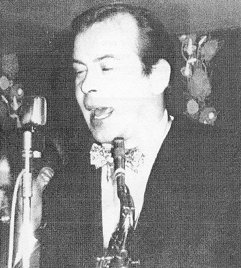
Tommy Burton.
Tommy in typical rocking style. There can never be
anyone to match him! (Tommy Burton) |
It was not until
the increased popularity and improved reception of Radio
Luxembourg in this country or the advent of the pirate
radio stations off British shores that disc jockeys
first became significant media personalities. The early
60s saw Luxembourg disc jockeys like Jimmy Saville and
Keith Fordyce being listened to intently by British
teenagers, when the reception actually allowed, as
remembered by one of those teenagers:
"Every
Wednesday night at ten I would try to pick up 208 for
the Teen and Twenty Disc Club with Jimmy Saville. It was
always the first station to play the latest American
releases. There was nothing better than to go to school
on the Thursday and be able to announce that you had
heard the latest record by Del Shannon or Elvis."
|
|
Radio Caroline
and the other pirate stations 'opened up' the whole
record market for most teenagers since they offered
opportunities to hear many records which were just not
being played on the BBC. In fact, Caroline probably
'created' a fair proportion of the hits of the mid-60s,
especially for some of the smaller record labels.
As with Radio
Luxembourg, the pirate stations had their own 'star' DJs
like Tony Blackburn, John Peel, Stuart Henry, Kenny
Everitt etc. It was such men who became the nucleus of
BBC Radio One's team of disc jockeys when it began
broadcasting in 1967. One result of the success enjoyed
by radio disc jockeys was an increase in the number of
locally based DJs who started to appear at many of the
regular live music venues in the area. Perhaps the best
example of this relatively new phenomenon was Barmy
Barry. He was apparently introduced to the town by
Roger Allen:
"I brought
Barmy Barry down to the Cleveland Arms one night when
the group failed to turn up. He was a real showman and
went down so well that I decided that we must use him
regularly. That first night he arrived with his hair
four different colours and with odd socks on. He
entertained the audience for two hours and continued to
do so for years after. It was quite against my natural
instinct since I much preferred live music but he was
something else." |
|
The success of
Barmy Barry was such that within a relatively short time
he was appearing at a wide range of local venues
alongside many of the more popular groups. He was
recognised as 'special' and many punters were as much
fans of Barmy Barry as of the groups.
Many customers
regarded an evening which included one or two of the top
groups and Barmy Barry as better than an evening with
just a group. Other local DJs like Andy Archer, Evo
Evans, Oscar Michael, Spangles Muldoon, Farmer Carl,
Sheiky, Mr. Max emerged, as another of those early DJs,
the General, describes:
"While I was
in the orphanage I would listen to Sam Costa and Jack
Jackson on BBC radio and Jimmy Saville on Luxembourg
with the Teen and Twenty Disc Club and I decided that I
would love to do that." |
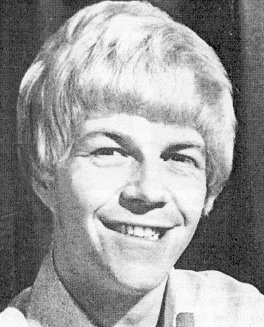
Barmy Barry.
The most outrageous DJ of his generation but one hell of
a showman. (Mel Brookes) |
| "I became a resident DJ at the
Ship and Rainbow on Fridays, Saturdays and Sundays. It
was a great venue. I got to play with nearly all the
local groups and at all the main venues and loved every
minute of it. Loads of young DJs contacted me and said
they were willing to DJ at the Ship and other venues for
nothing just to get near to some of the groups of the
time." |

Andy Archer.
A resident DJ at the Lafayette. Maybe not the showman
that Barmy Barry was but an excellent ‘jockey’. (Mel
Brookes) |
One definite
advantage of hiring a disc jockey, as far as the
managers or owners of the venues were concerned, was
that they could guarantee that the latest records were
played, rather than 'copied' by one or other of the
groups.
Punters
themselves were keen to hear and dance to the latest
records, as much as hearing any of the groups attempting
to replicate the sounds, and often failing. In the same
way that the groups were competing for the attention and
support of the punters, so did the disc jockeys.
The more
individualistic the DJs became, the better they were
liked by many of the punters. That accounts for the
success of someone like Barmy Barry. He became the model
to which many young DJs aspired. |
|
Keith Evans
ultimately became Evo, the DJ, after he left the
Californians. As he describes it himself:
"I'd had a
few disagreements within the group and a few
disappointments so I decided to leave the group scene. I
joined Roger Allen for a spell, working with the agency
and then compering at his club, the Oasis. It was while
I was there that George Maddocks asked me if I would
like to fill in at the Lafayette for the resident DJ
while he was on holiday. I went for two weeks and stayed
for five years."
"It was at
the time when more and more clubs and other venues were
hiring DJs and organising discos rather than taking on
groups. It made sounder financial sense as far as the
management was concerned. The younger punters were also
keener on the sounds being found on record than the
sounds being made by many of the groups. Remember this
was at the time when the disco period was first
beginning.”
The vast majority of group members
saw the advent of the discotheque (disco in the 70's)
and the professional disc jockey as the main reason for
the final eclipse of the group scene. It became
increasingly obvious that the generation who had
provided the original fan-base for the beat/pop groups
was being replaced by a new and younger generation who
regarded many of the remaining groups as 'old-hat' and
alien to themselves and their tastes in music.
It obviously did not take too long
for the changing tastes of the clientele to determine
the policies of the management of the various local
venues. As one surveys the entertainment pages of local
newspapers during the latter months of the decade and
into the next decade there is a steady decline in the
number of references to local groups performing in the
area and a corresponding increase in the number of
discos and disc jockeys.
Some of the groups did manage to
continue into the 70s and worked steadily throughout
much of the period, but they were those who had
successfully changed their format and style to match the
changing patterns of taste and moves towards 'glam
rock'. The most obvious example being Slade who
became for many the 'ultimate 70s group'. There were
those who were able to meet the increasing demands of
the rock scene for greater amplification and
increasingly large lighting units like Trapeze
who were to find great success in the United States or
those who were able to continue to produce the all-round
variety requested by the cabaret circuit like the
Montanas. |
| For the majority of bands
however, the end of the 60s saw a general decline into
virtual oblivion. So many of the members seemed to pass
from being 'local heroes' to being 'faces in the crowd',
their moments of glory gone. But for so many of the
generation who grew up in this area during the 1960s
they have remained part of our psyche and will never be
totally forgotten.
It is still possible to meet other
fifty-something's and discuss the relative instrumental
and vocal merits of so many of those groups who
epitomised a period of time in our local history. |
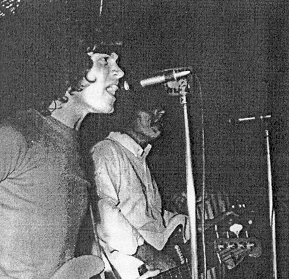
|
Glenn Hughes.
He moved from Finders Keepers to Trapeze to
Deep Purple and onwards. Still belting out
to this day. A magnificent voice! (Anna
Terrana) |
|
 |
 |
 |
Return to
the
previous page |
Return to
the Contents |
Proceed to
part 8 |
|